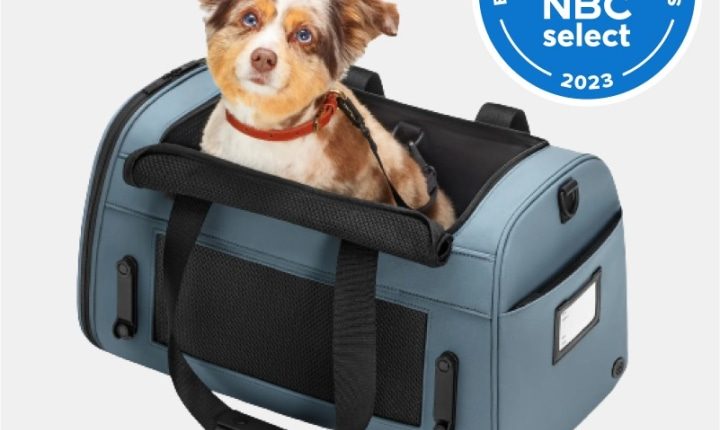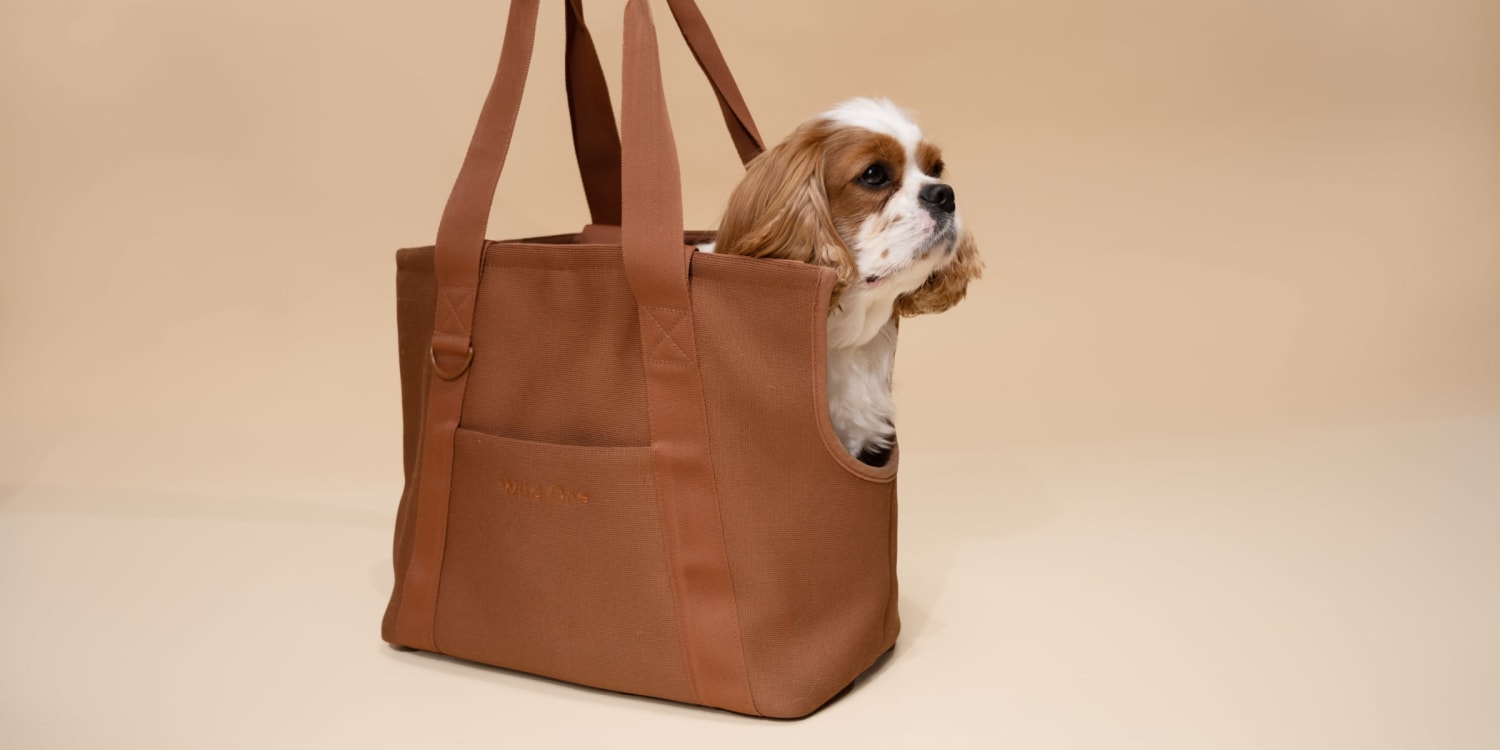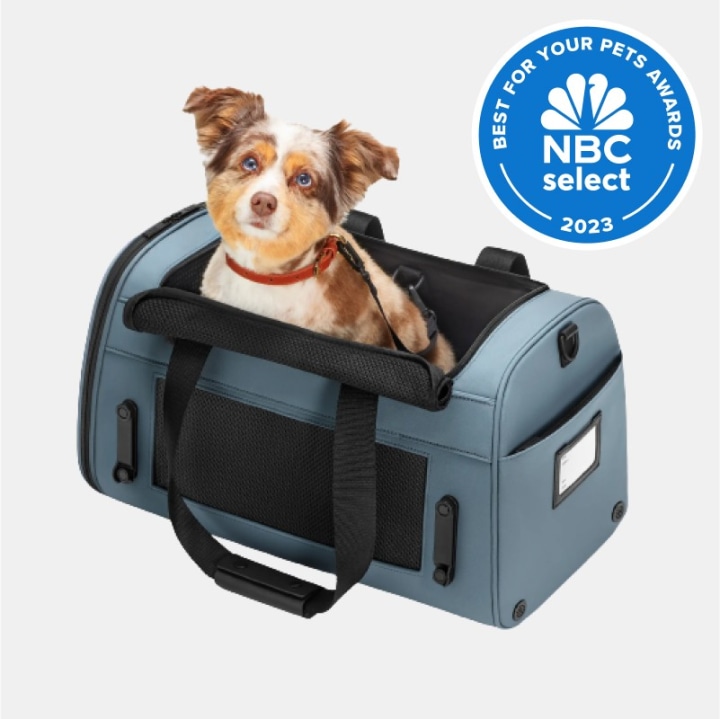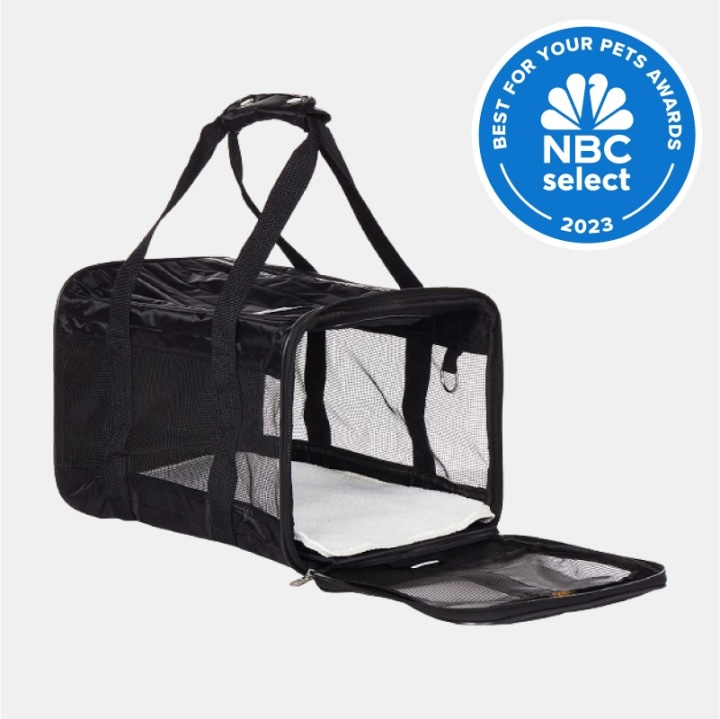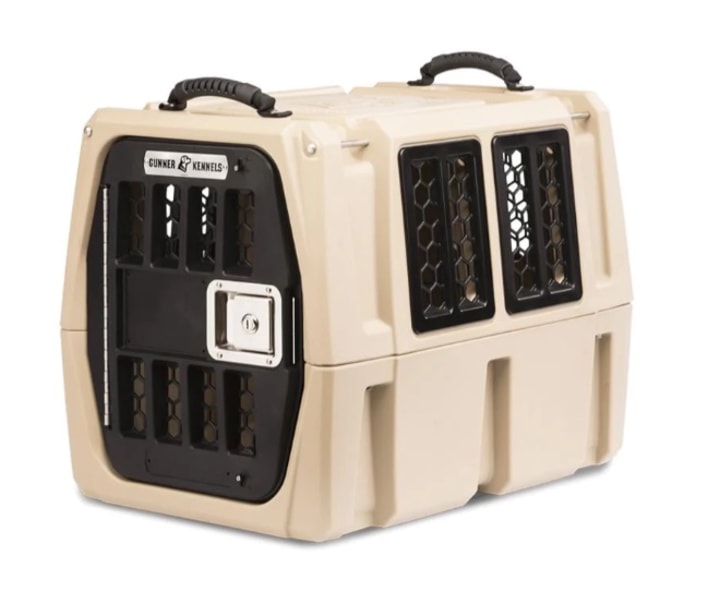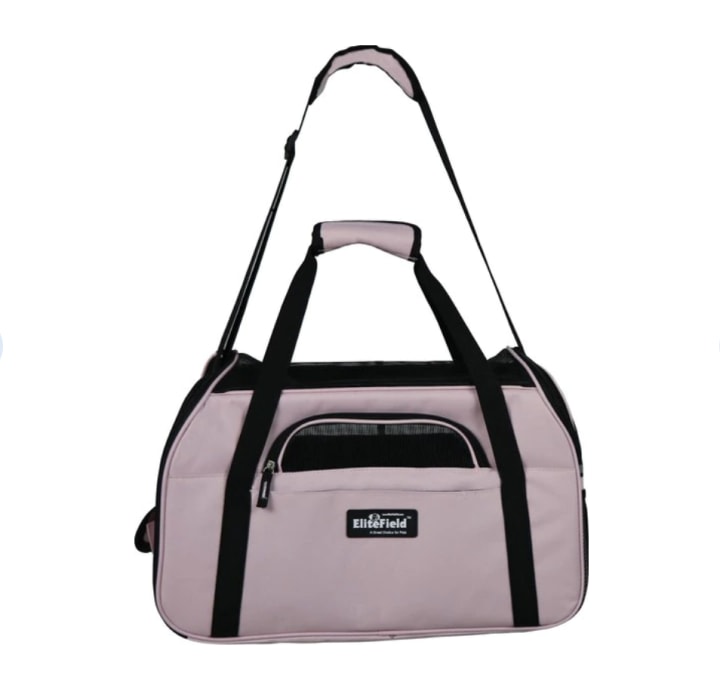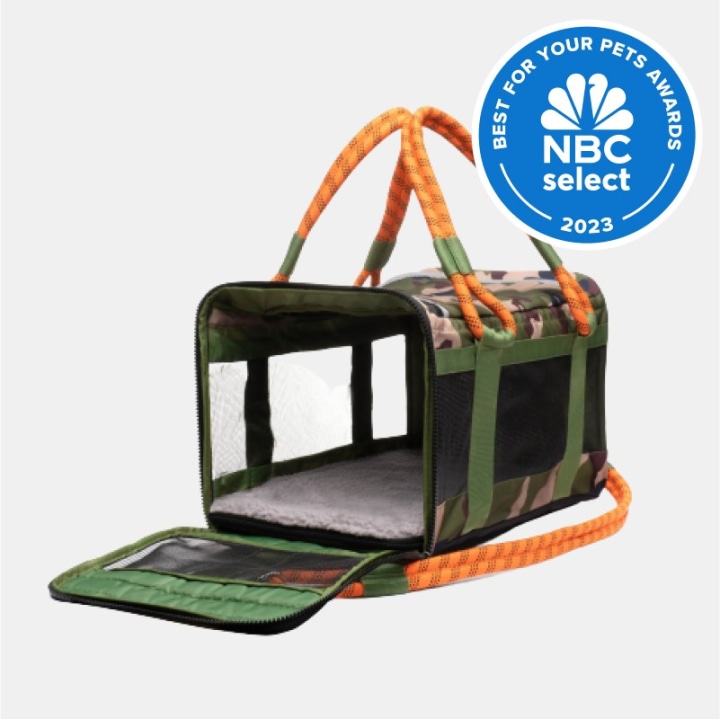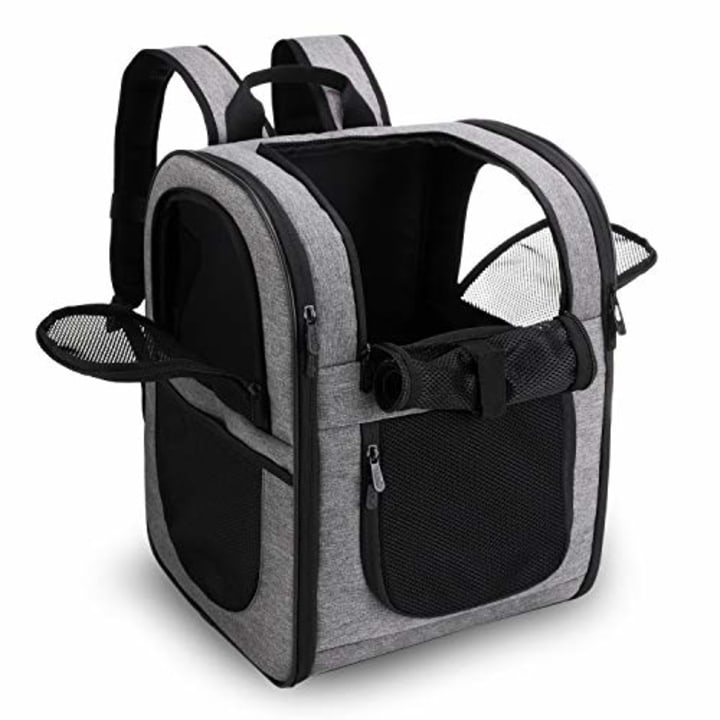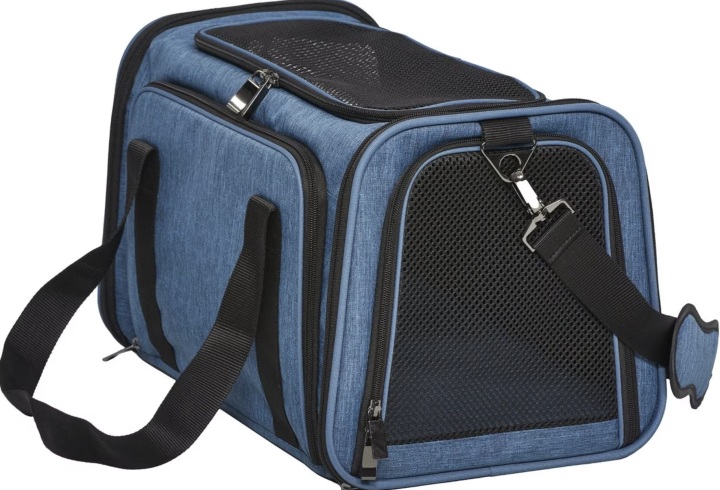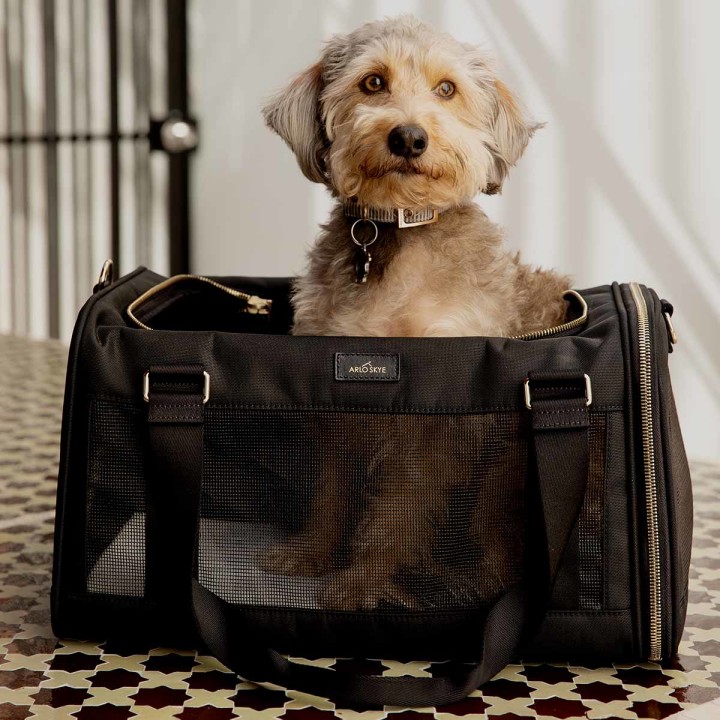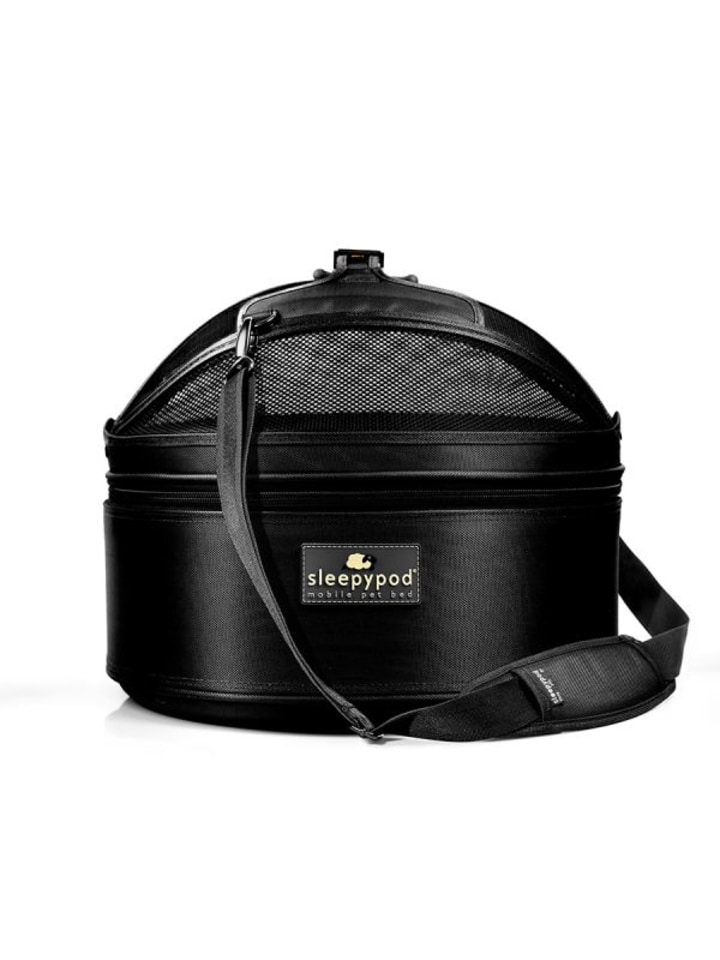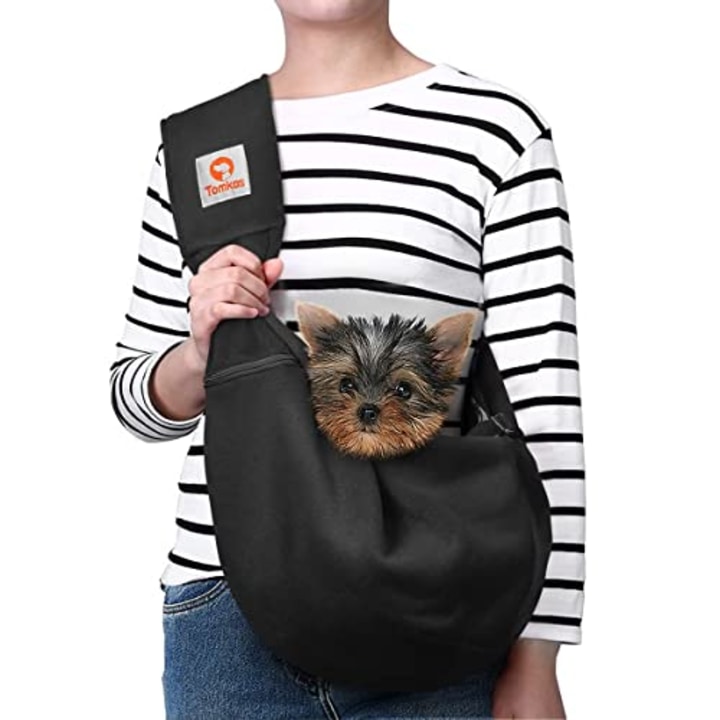We all want our dogs by our side as much as possible, and that might include them tagging along on vacations and holiday trips. But traveling with a pet usually involves a range of safety considerations, including gathering the right health paperwork, keeping treats and water on hand and making sure they’re as comfortable as possible on a flight, train or car ride. Since most airlines and other transportation methods will require taking your dog in some type of enclosure, the pet carrier you choose is very important to keep your dog safe and comfortable.
We spoke to veterinarians, vet technicians and travel safety experts about what to look for in a travel carrier for your dog and how to shop for one that’s both comfortable and safe. We also listed expert-recommended carriers and Select staff favorites.
SKIP AHEAD Best dog travel carriers | How to shop for a dog travel carrier | What size carrier is allowed on a plane? | What is the pet weight limit for air travel? | What’s the difference between a carrier and crate? | Is it safe to travel with a pet in the cargo area? | How to help your dog feel calm in a travel carrier
Our top picks
How we picked the best dog travel carriers
When shopping for the best travel carrier for your dog, our experts recommend considering the following factors:
- Size: Pick a carrier that’s big enough for your pet to comfortably stand, sit, lie down and turn around in. The carrier should be as long as the tip of the dog’s nose to the base of the tail, according to veterinarian Dr. Kristen L. Nelson. Carriers will usually come in a variety of sizes to fit different breed types (though keep in mind that airline-approved carriers have very specific dimension requirements that will usually only fit small dogs under 20 pounds, according to our experts).
- Materials and build: Carriers are usually soft-sided and made of polyester or nylon, which are easy to clean and water- and tear-resistant, according to our experts. Choose a carrier with mesh sides to provide a good amount of ventilation. Most importantly, you should opt for a carrier that can stand up on its own and not collapse around your pet or deform easily, says Dr. Christina Carlo, a veterinarian and medical director at VCA Avondale Veterinary Hospital. Hard plastic carriers are usually designed for airplane cargo holds, but they’re a safe and durable option for car rides, too, according to Carlo.
- Airline requirements: Commercial airlines will usually have certain dimension requirements for carriers that go in the plane’s cabin (with the passenger) and crates that travel in the cargo area of the plane. Most airlines like United Airlines, Jetblue and American Airlines have varying dimension requirements, so be sure to visit their site before traveling.
- Crash testing: Look for carriers and crates that have undergone independent crash testing by the Center for Pet Safety, which gives your pet the best possible chance of survival if a crash occurs, says Dr. Wendy Hauser, a veterinarian and special advisor to ASPCA Pet Health Insurance.
Best dog travel carriers of 2023
Below, we gathered the best travel carriers for your dog based on experts’ guidance and Select staff experience. We also included top-rated options with a 4-star average rating or higher. We list key factors to consider, including the carrier’s material, weight capacity and dimensions.
Best overall travel carrier: Away
Away The Pet Carrier
This Away travel carrier is designed for both car and airline travel and won a Select Best for Your Pet award for best overall travel carrier. It has zip openings on the top and front with fully see-through mesh to help your pet see out of the carrier (if you prefer to avoid this, there’s a piece of fabric that rolls down to cover their view).
I use this carrier to fly with my 16-pound havachon, Bella, because it’s sturdy and makes her feel safe and supported thanks to its durable nylon and leather construction. The mesh gives her enough visibility to know what’s going on outside and helps me keep tabs on her, too. It also comes with machine-washable bedding on the inside that’s soft to the touch, and multiple pockets that keep my belongings and pet essentials accessible during the whole flight. If you’re traveling by car, the carrier has latches on one side that securely fasten to a car’s seat belt system. The Away carrier comes in black and blue colors and you can also personalize it with your initials for an additional $35.
Pet weight: Up to 18 lbs | Dimensions (LxWxH): 18.7 x 10.8 x 10.75 in. | Material: Water-resistant nylon
Best airline-approved carrier: Sherpa
Sherpa Pet Carrier
Another Best for Your Pet award winner, this Sherpa carrier is a favorite of CPS founder Lindsey Wolko, who has used it for years to travel with her own pets. She specifically recommends it for traveling on the plane because it fits under the passenger seat (it meets the dimensions for most airlines, but always check your specific airline’s requirements before traveling) and has a large zip pocket to store pet supplies like water bowls, leashes and treats. However, it’s not the best pick for car travel because you can’t strap it in using your vehicle’s seat belt system — you’re better off placing it on the floor behind the driver’s seat for safety and to avoid the stitching or zippers to fail, says Wolko.
NBC Select manager of editorial operations Shari Uyehara uses this carrier to take her 20-pound cavalier King Charles spaniel, Loki, on the plane and says it’s a great affordable option for travel. Loki can comfortably shift positions during the flight, and the carrier itself is structured enough to maintain its shape while under the seat, says Uyehara. The sides are made of see-through mesh that allows your pet to easily see out of it. Available in medium and large sizes, the carrier also has shorter top handles and a longer shoulder strap to fit your carrying preferences.
Pet weight: Up to 16 lbs | Dimensions: 17 x 11 x 10.5 in. (medium size) | Material: Polyester and mesh
Best hard-sided carrier for cargo: Gunner
Gunner Kennel G1
This crate earned a 5-star safety rating from the CPS in both the crate and carrier class (the only product to earn a dual certification), and it’s a favorite among our experts. The crate has a thick exterior layer for impact protection, which keeps your pet safe if there’s a crash or a fall, according to the brand. It also has a reversible door design that lets you open the crate from either side. The door also has an aluminum frame that won’t pop open in the middle of a flight, according to the brand. It comes in four sizes — small, medium, intermediate and large — and Gunner offers a size guide that gives recommendations based on your dog’s weight and length.
Pet weight: Up to 30 lbs for small, up to 45 lbs for medium, up to 75 lbs for intermediate and up to 110 lbs for large size | Dimensions: 24.5 x 18.625 x 19 in. (small), 29.5 x 20.5 x 23.5 in. (medium), 34 x 23 x 28.5 in. (intermediate), 40.25 x 28 x 33.25 in. (large) | Material: Reinforced aluminum frame
Best soft-sided carrier: EliteField
EliteField Soft-Sided Dog & Cat Carrier Bag
This pet carrier weighs just over 2 pounds and is the most lightweight soft-sided option on this list. The carrier is recommended by Dr. Amber Karwacki, a veterinarian and partner doctor at Heart + Paw in Callowhill, Pennsylvania, because it has mesh panels on both sides and the front to let air in and prevent your pet from getting too hot, according to the brand. It also comes with removable and machine-washable bedding and has a back sleeve that attaches to your suitcase, as well as loops that latch onto your car’s seat belt system. The polyester and synthetic build is water-resistant and available in six colors to fit your personal style.
Pet weight: Up to 18 lbs | Dimensions: 19 x 10 x 13 in. | Material: Polyester
Best tote carrier: Wild One
Wild One Everyday Carrier
If you’re looking for a tote to carry your dog around town or on the train, consider this Wild One carrier. This Select staff-favorite option has a small dip in its design, which allows your dog to peek their head out while you carry them around. Uyehara particularly loves how stable the tote is. “I love that Loki’s weight remains balanced in the carrier, but he still has room to move around,” she says. It also includes a safety clip that attaches to your dog’s harness, which ensures your dog is secure and won’t jump out at a bad time, according to Karwacki (but be sure to never connect this clip to their collar since it poses a choking hazard). It also comes with carrying straps of two different lengths — one length to carry it like a shoulder bag, and shorter straps to carry it by hand. There is a machine washable mat on the inside and three exterior pockets to hold all your pet’s essentials like bags, treats and toys.
Pet weight: Up to 20 lbs | Dimensions: 21.5 x 7.5 x 14.25 in. | Material: Recycled polyester outer, cotton interior
Best collapsible carrier: Roverlund
Roverlund Out-Of-Office Pet Carrier
Another Select Best for Your Pet award winner, the small version of this Roverlund carrier is an airline-approved option for both dogs and cats because it’s less than 18 inches long. The straps are all ropes, which our staff found to be more comfortable and supportive than other carrier straps made from typical polyester or fabric. The interior lining is machine-washable and you can also shop the larger version of this carrier for dogs up to 25 pounds.
Pet weight: Up to 20 lbs | Dimensions: 17 x 11 x 10.5 in. (small size) | Material: Water-resistant polyester, mountain climbing rope
Best backpack carrier: Apollo Walker
Apollo Walker Pet Carrier Backpack
This highly rated backpack carrier, which earned a 4.6-star average rating from over 4,500 reviews on Amazon, has shoulder straps and two separate straps that buckle around your sternum and waist to help evenly distribute the weight of your pet, according to the brand. It has mesh panels on all sides to let your pet see out and comes with removable fleece bedding to keep them comfortable while creating a sturdy base that can hold their weight, according to Apollo. It also comes with a clip that attaches to your pet’s harness to prevent them from escaping or falling out.
Pet weight: N/A | Dimensions: 12.6 x 11.4 x 16.8 in. | Material: Polyester
Best expandable carrier: Midwest
Midwest Duffy Dog & Cat Carrier
This Midwest Duffy carrier is recommended by Karwacki because it’s expandable — the mesh sides open up to give your pet more room to move around and stretch their legs. It has two zippered side openings, as well as one on top to make it easier to take your dog in and out of the carrier, according to the brand. It also folds completely flat, so you can store it away when it’s not in use. It comes in three colors and sizes small, medium and large.
Pet weight: Up to 15 lbs | Dimensions: 16.3 x 10.1 x 9.3 in. (small), 18.3 x 11.3 x 11.1 in. (medium) and 19.3 x 12.2 x 12.2 in. (large) | Material: Polyester
Best carrier for medium-sized dogs: Arlo Skye
Arlo Skye The Pet Carrier
This Arlo Skye pet carrier has mesh panels on all sides, making it a well-ventilated option for your pup. It comes with memory foam bedding on the inside that’s both removable and machine-washable, as well as a foldable design to help you pack it easily in your suitcase or travel bag, according to the brand. It has dual openings on both ends and a back pocket sleeve to place it over your carry-on. The carrier is also highly rated with a 4.9-star average rating from over 60 reviews at Arlo Skye.
Pet weight: Up to 25 lbs | Dimensions: 17.5 x 11 x 10 in. | Material: Poly-mesh and nylon
Best carrier for small dogs: Sleepypod
Sleepypod Mobile Pet Bed
The Sleepypod Mobile Pet Bed is an expert-recommended and CPS-certified option that has breathable mesh and a machine-washable interior — it’s built for plane travel for dogs under 15 pounds. Nelson recommends the Sleepypod because it’s easy to carry and gives the pet privacy while traveling since it’s fully enclosed with a mesh panel at the top.
Like several other carriers on this list, the Sleepypod doesn’t just limit itself to airline travel: It straps into a vehicle’s seat belt system, so you can comfortably take road trips with your pet. You can also separate the bottom of the carrier to transform it into a bed for your pet, which makes training easier since they can form a positive association with it, says Lindsey Wolko, founder of the Center for Pet Safety. The brand’s Sleepypod Atom is another CPS-certified carrier that’s crash-tested for even smaller dogs up to 12 pounds, the lowest weight requirement on this list.
Pet weight: Up to 15 lbs | Dimensions: 17 in. (D) x 6.5 in. | Material: Polyester
Best sling carrier: Tomkas
Tomkas Dog Sling Carrier
Designed for small dogs up to 10 pounds, this sling carrier crosses over your body so you can take your dog around town hands-free. The base has a built-in drawstring that adjusts the size of the opening to fit different sized dogs, and the crossbody strap length is also adjustable to fit your comfort level. The carrier includes a safety buckle inside that connects to your dog’s harness to prevent them from falling out, according to the brand. I purchased this carrier for my havachon, Bella, when she was a puppy weighing under 10 pounds, and I was able to comfortably carry her around when she got tired of walking. It held her weight well without tearing or damaging the fabric, and the crossbody strap caused less strain on my back.
Pet weight: Up to 10 lbs | Dimensions: 9 x 6 x 3 in. | Material: Polyester
How to shop for a dog travel carrier
Carriers and crates are the most secure type of enclosure when traveling with your dog because they prevent them from escaping and minimize distraction while you’re traveling (especially while driving), according to Wolko. But the right carrier for your dog will depend on what type of trip you’re taking, your method of transportation and their temperament.. When shopping for the right carrier for your dog, our experts recommend considering the size and fit of the enclosure, whether it’s crash-tested, if it meets airline requirements and more.
Size
Your dog or cat should be able to easily stand up, turn around and lay comfortably in their carrier. That means the length of your carrier from front to back should measure about the same, or one or two inches more than the tip of your dog’s nose to the base of their tail, according to Nelson. You should add a few more inches for brachycephalic breeds like pugs, pekingese and French bulldogs, though experts don’t recommend taking these breeds on flights because their shorter noses increase the risk of overheating and oxygen deprivation, says Nelson (some airlines even ban this breed from flying in the cargo hold, according to the American Veterinary Medical Association). To determine the right height of your carrier, make sure it measures the same or larger than the height of your pet from the floor to the top of their shoulders, says Carlo.
Comfort
Place a mat or bed in the carrier to make the space more comfortable for your pet, says Carlo (though you should avoid this if your dog usually destroys their bedding because they might eat the pieces and cause intestinal obstruction). Putting soft blankets or their favorite toy in the carrier can also help promote familiarity and make them feel safe, according to our experts.
Whether your dog can see out of their carrier is a matter of personal preference, though our experts recommend mesh so the outside is visible, which helps avoid your dog feeling threatened or confused while they’re traveling, says Wolko.
Materials and structure
Most carriers are soft-sided and made from materials like polyester, mesh and nylon fabric. Consider whether the carrier has structure, meaning it can stand up on its own and won’t automatically collapse around your pet, according to Carlo. You should also look for carriers that have pockets, so you have room for your pet supplies.
You can take a hard-sided, non-collapsible crate or kennel on an airplane, but they must be able to fit under the passenger’s seat, according to Hauser (this might be harder to do compared to soft-sided carriers since they don’t mold to a different size). Plastic hard-sided crates are usually good for transporting your pet in an airplane cargo hold and the cargo area of a car — they’re considered to be the safest option since they won’t lose their shape and provide impact protection in case of a crash, turbulence or hard fall, according to our experts. However, you should avoid metal wire crates because pets might be able to stick their feet or limbs out, which can be a safety hazard while traveling, says Karwacki.
Safety considerations
For car travel, look for carriers and crates that have undergone crash testing by the Center for Pet Safety, a registered nonprofit and advocacy organization that crash tests car restraints and containment devices. This provides an extra layer of safety when traveling with your pet, our experts say.
“Most carriers on the market only prevent distractions [for the driver], which is important, but in a crash, they may not perform as you would expect them to,” says Wolko. The CPS certification tests carriers as an unaffiliated third party. This is important when considering that many brands subjectively “pass” their carriers if they test them in their own labs, which can ultimately give pet owners a false sense of security, according to Wolko.
Though the CPS does not specifically test carriers and crates for airline travel, you can use most carriers that meet the airline’s size requirements and have ample ventilation, according to Wolko.
A CPS-certified crate usually has backup door latches and locking mechanisms to prevent your pet from escaping, which is especially useful if they travel in the aircraft’s cargo hold. “So, if something tumbles, the kennel is so robust that the pet is not getting out,” says Wolko. Most airlines have certain regulations for what carriers to use when transporting an animal in the cargo area of a plane. The International Air Transport Association, a globally recognized trade association for the world’s airlines, details specific requirements for crates to transport animals in the cargo hold, including construction and adequate ventilation (more on that below).
What size pet carrier is allowed on a plane?
For air travel, always check with your airline to see what type and size of carrier it allows. The approved dimensions of your carrier vary from airline to airline but, in most cases, carriers can’t exceed 11 inches in height, which allows it to fit under the seat in front of the passenger, according to Hauser. Also, the carrier will likely count as your carry-on luggage on most airlines, and in-cabin travel will usually require you to make a reservation or reserve a seat specifically for your dog.
What is the pet weight limit for air travel?
Certain airlines might also have specific pet size and weight requirements for in-cabin travel. Typically, pets must weigh 20 pounds or less, though this varies by airline, and most larger dogs can’t ride in-cabin unless they’re a trained service animal, according to Wolko. If your pet exceeds that limit, they’ll need to travel in the cargo area of the plane.
Most airlines will allow trained service dogs on board at no cost. However, several airlines like Delta Air Lines, Southwest, American Airlines and Alaska Air are no longer accepting emotional support animals on board.
What is the difference between a carrier and a crate?
Carriers and crates for dogs are usually used interchangeably, but there are a few key differences. The CPS defines crates as enclosures that are secured in the cargo area of a plane or tethered securely to the floor of a vehicle like a van or SUV. They’re usually constructed of thick molded plastic or metal and designed for larger dogs, according to our experts.
Carriers, on the other hand, are usually designed for smaller dogs and made of a soft-sided fabric (though some are constructed of a harder plastic or nylon to prevent them from collapsing on your pet). When traveling in a car, the carrier usually goes in the backseat and is strapped in using the seatbelt system of your vehicle.
Is it safe to travel with a pet in the cargo area?
Yes, it is generally safe and common to travel with your dog in the cargo hold (also known as the lower deck) of an airplane, which also holds baggage. However, experts recommend only flying your pet in the cargo hold when it’s absolutely necessary because it can be a very stressful experience for them.
“There’s a lot of weird noises, not much light down there — it’d be scary for anyone to go in the [cargo hold], ” says Karwacki. And, most handling risks come before they even board the plane: Dogs usually endure the most force when being transported across the rough, uneven tarmac to get to the plane, says Wolko.
The IATA lists specific requirements for crates, including construction and ventilation, to keep your pet safe when flying in the cargo hold. For example, the trade association specifies that crates must be sturdy and inescapable and adequately ventilated on three sides, with the majority of the ventilation being provided on the upper part of the container.
Most aircraft cargo holds are temperature-controlled and pressurized, according to the U.S. Department of Agriculture. Animals can’t be exposed to temperatures above 85 degrees Fahrenheit or below 45 degrees Fahrenheit for more than 4 hours, per the USDA’s website. Most airlines won’t transport dogs altogether if ground temperatures reach those extremes.
How to help your dog feel calm in a travel carrier
Your pet’s comfort level in their carrier can determine how smooth your travels are. Below, we list a few expert tips about how to get your dog adjusted to their carrier and how to keep them comfortable during long trips.
- Know your dog’s safety and security preferences. Some dogs prefer more open-sided kennels with better airflow and visibility, while others feel safer with the cave-like security of a molded plastic carrier with smaller windows, says Hauser.
- Make the carrier or crate their “happy spot.” Allowing your pet to build a positive association with their carrier helps them feel calm and safe while traveling, according to our experts. In your home and before traveling, leave the door open so that your pup can explore the enclosure on their own terms, which demystifies it, says Hauser. After some time, it isn’t uncommon to find pets that preferentially sleep in their enclosures,” she says. Once they get acclimated to the crate or carrier at home, you can then graduate to car trips and, later on, plane rides. Start off with brief trips that increase in duration over time.
- Make the carrier feel familiar. As we mentioned, putting their favorite bed, blankets or toys in the carrier can help make them feel more comfortable.
- Avoid any safety risks while on the plane. For example, if you’re traveling with your pet in-cabin, never put the carrier in the overhead compartment of the plane with your pet inside because it poses a suffocation risk, says Wolko. Also, feed your pet before you get on the plane — if they choke or get something lodged in their throat while you’re in the air, they likely won’t get help in time, according to Wolko.
Meet our experts
At Select, we work with experts who have specialized knowledge and authority based on relevant training and/or experience. We also take steps to ensure all expert advice and recommendations are made independently and without undisclosed financial conflicts of interest.
- Dr. Kristen L. Nelson is a veterinarian and author of “Coated With Fur: A Vet’s Life.”
- Dr. Christina Carlo is a veterinarian and medical director at VCA Avondale Veterinary Hospital.
- Dr. Wendy Hauser is a veterinarian and special advisor to ASPCA Pet Health Insurance.
- Lindsey Wolko is the founder of the Center for Pet Safety, a registered nonprofit and advocacy organization that crash-tests car restraints and containment devices for pets.
- Dr. Amber Karwacki is a veterinarian and partner doctor at Heart + Paw in Callowhill, Pennsylvania.
Why trust Select?
Mili Godio is an editor at Select who covers a variety of pet topics, including dog food, beds, treats and toys. For this article, Godio spoke to five veterinarians and pet safety experts about the best carriers for your dog and how to safely travel with them. She also compiled their recommendations for the best travel carriers to consider and researched dozens of options on the market based on expert guidance.
Catch up on Select’s in-depth coverage of personal finance, tech and tools, wellness and more, and follow us on Facebook, Instagram, Twitter and TikTok to stay up to date.
Source: | This article originally belongs to Nbcnews.com
